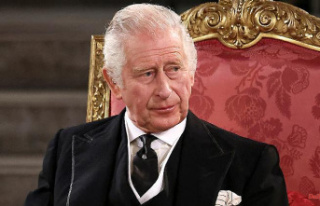Queen Elizabeth II is dead. And has been for six days. But before she finds her final resting place, she still has a few mandatory appointments to complete. So that they do not become a burden for their people, the corpse must be prepared accordingly. How to do that.
The Queen - a life of duty. But even after her death, the mortal remains of the monarch will not rest until her body is buried in the family vault of St George's Chapel in the grounds of Windsor Castle on Monday 19 September.
Until then, the coffin with the body of Queen Elizabeth II was and will be driven around and laid out for a total of eleven days. Your subjects and onlookers should be able to say goodbye in this way. One can almost say fortunately that the former empire has significantly reduced in size in the last 100 years, otherwise an end to the hardships would not be in sight.
But even these eleven days between death, transport, public display and burial are no small matter, especially when you consider that the putrefaction of the human body begins about one to two days after death. Which brings us to the question of how to prevent bystanders from being stunned by the smell of decomposition as they pay their respects.
Both RTL and the "Redaktionsnetzwerk Deutschland" (RND) have interviewed experts who provide information about possible methods of preserving the corpse. The press spokesman for the undertakers' association of Lower Saxony, Markus Gebauer, explains the RND: "In order to inhibit the natural process of decomposition, the body fluids are exchanged with formaldehyde and other chemicals". For this purpose, arteries and vessels are opened. What can then be understood by the term embalming, even if nothing is applied to the body from the outside. This embalming can take anywhere from two to six hours depending on the condition of the body. In this way, the deceased can be preserved in a presentable condition for two to three months. The following applies: the faster the body fluids are exchanged, the better the condition of the corpse can be preserved.
And on RTL, the certified thanato practitioner Philipp Berger from the German Embalmers Association explains: “We take care of the preservation of the deceased. This involves temporarily interrupting the autolysis – i.e. the decomposition of the body, so that the burial or the farewell in the open coffin can take place at a later date".
He also informs that embalming can be repeated at regular intervals. For example, if a dead person is to be presented to people for months or years. "The best example of this is Mr. Lenin in Moscow. He has injections every 12 months. Depending on the procedure, embalming can be sufficient for a year," says Berger. The embalmed body of the Russian revolutionary leader, who died in January 1924, has been laid out in a mausoleum in Moscow ever since.
But the process is not only used for celebrities who are on display. For example, embalming is required if someone dies in Germany and is to be transferred to their home country. At least if there is a long time between the occurrence of death and the farewell or funeral, the expert informs Berger.
Whether the body of the late Queen Elizabeth II was subjected to such treatment is anyone's guess, and no statement from the palace is expected. Just like the question of whether the coffin might even be empty. The undertakers' association of Lower Saxony, however, considers embalming to be very likely. The "Bild" newspaper would also like to have heard that the body will be preserved with special cooling plates until the burial.
In addition, the Queen's coffin may have been and is being transported in a refrigerated hearse. "Many hearses have separate cooling, which can be switched on especially for long-distance transfers," explains Gebauer.












